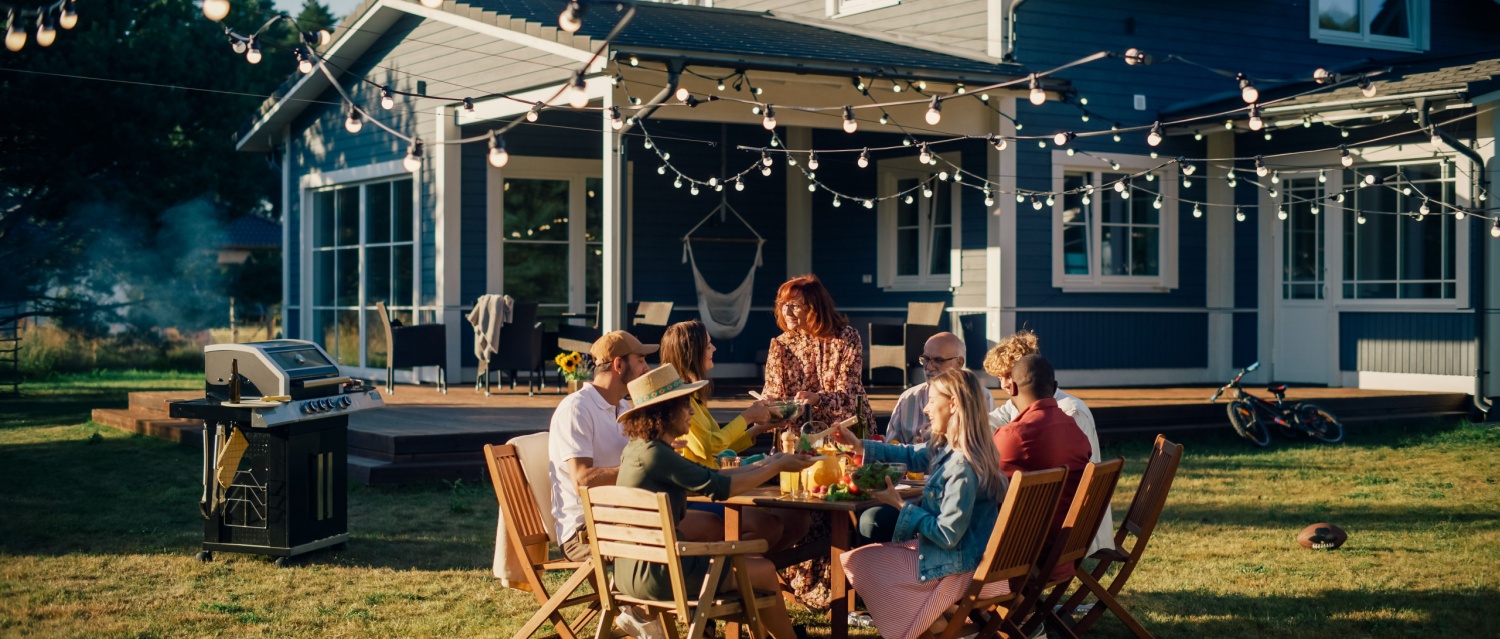Food is at the heart of Italian life – and nothing connects you to the country more than cooking like the locals do. Our writer, Julia, shares her insights into Nonna’s wisdom, regional specialities and the simple joy of creating meals that bring family and friends together.
Once you have your own kitchen in Italy, you’ll be able to cook like a local and have friends round for dinner on the terrace. With fresh seasonal vegetables grown locally and some tips from an Italian grandmother (nonna), you can’t go wrong. I suspect that many an Italian Chef developed their love of cooking in the kitchen of their nonna.
Some of the most well-known chefs in the world admit to being greatly influenced by the incredible authentic flavours of Italian home cooking: Antonio Carluccio, Angela Hartnett and Lidia Bastianich, to name just a few. They have all learnt that by letting the natural flavours of fresh ingredients take centre stage, a few simple cooking techniques can create dishes that are heaven on the tongue.
That Italian passion for food
Even TV programmes, such as Stanley Tucci’s Searching for Italy, inevitably see the presenter end up in an Italian kitchen. And the cook will always talk with such passion and enthusiasm for the food they create, proud of their culinary heritage and the recipes handed down to them.
One quote from Stanley Tucci’s book is: “Perhaps the most precious heirlooms are family recipes. Like a physical heirloom, they remind us from whom and where we came and give others, in a bite, the story of another people from another place and another time.”
Regional specialities
When I lived in England, I struggled to name any regional dishes. Yorkshire pudding and Cornish pasties were about it. In Italy, cultural heritage is important and traditional crafts, dances, music, farming methods and recipes are handed down from generation to generation.
In Piedmont they have the gran bollito misto, a dish of five cuts of meat and three sauces, which used to be served in the royal palaces. In Bergamo, in the Lombardy region, there is an egg pasta called casoncelli, which is a filled with veal and cheese, with butter, Grana Padano, sage and bacon. And, if you enjoy the occasional steak, you have to try bistecca alla Fiorentina, the famous dish of Tuscany.
Some of Italy’s most popular dishes come from the Lazio region. These include pasta alla Carbonara and pasta cacio e pepe. Another tasty dish, once cooked by peasants in Lazio, is the gnocchi alla Romana. This type of gnocchi is large disc shaped dumplings, prepared with a mixture of semolina, eggs, milk, butter and parmesan and baked in the oven until crispy. While in the neighbouring Campania region there is of course the world-famous Pizza Napoletana.
Cucina povera
Many so-called “peasant dishes” are now finding their way into the kitchens of top chefs. Known as cucina povera, which translates to “poor kitchen”, this style of cooking demonstrates how with a few simple ingredients you can still create a flavourful meal.
Italian dessert
In Tuscany, a traditional cucina povera dessert is castagnaccio, which translates to “chestnut cake”. Made with chestnut flour, its only sweetness are a few raisins. The most famous sweet dessert made in homes across Italy is the light and creamy tiramisu, which originated in Friuli-Venezia Giulia. And with a tub of mascarpone in the fridge, there are endless cheesecake recipes to try.
From land to table
In the early hours of the morning, you will see people tending their plots of land on the outskirts of town, before meeting up with friends in the piazza. It’s quite common to live in a town apartment and also have a plot of land in the countryside. It gives you the convenience of town amenities, while being able to ride your bike out to your countryside plot, where you might grow olive trees, grapevines, vegetables, fruit and nut trees. Nothing beats the taste of food you have grown yourself. Even if you only have a little outdoor space, you can grow herbs, tomatoes and chillies.
What do Italian families cook?
Most visitors to Italy will have eaten at restaurants serving local specialities. But have you ever wondered what an Italian family typically cooks at home? While breakfast might be a quick coffee and a biscuit, or milk for the children, lunch is usually the main meal of the day. In many areas three or four generations of a family will live close by, and when both parents work, it’s often grandma that prepares lunch (pranzo) for the family.
A typical family lunch

Often, families will sit down together at the table to eat lunch and talk. Meals need to be easy to dish up to a number of people of various ages. This is why pasta dishes, soups and risotto make a good first course (primo) or in the warmer months cured meats and cheeses. The main course (secondo) is usually meat or fish with a side dish (contorno) of vegetables or salad. Typical vegetables include zucchini, carrots, broccoli, spinach, cauliflower and peppers. The meat and pasta are often eaten without sauce or it is very light, maybe some passata or olive oil and a bit of grated parmesan. Finally, they might have some fruit or gelato.
Grilled vegetables
Fruit and vegetables are an important part of the meal, and it is preferable to serve whatever is in season in the area you live. How it is cooked will also depend on the season. In summer, try cutting circular slices of aubergine/eggplant (melanzana in Italian) and long slices of courgette (zucchini). Add some salt and leave for five minutes, then pat with kitchen roll to absorb the water. Then just pop them on the grill or griddle pan, which will leave grill lines on the vegetables.
To serve, you can simply trickle extra virgin olive oil over them with a little garlic and a sprinkling of parsley. They can be served as a side dish, or appetiser. They are also wonderful with crusty Italian bread or bruschetta; a dry crusty bread grilled and then drizzled with olive oil and a sprinkling of salt.
Bruschetta
Another, popular way to serve bruschetta is to rub garlic into warm bread, drizzle with olive oil, season with salt and top with chopped tomatoes and basil. Other toppings are also used, depending on the region and what is available. In Piedmont it might be anchovies and in Umbria they spread their bruschetta with black truffle pâté.
Pasta every day
My Italian friends have pasta every day for lunch. According to Statista this is very common, with Italian “citizens consuming an average of 23 kilograms of pasta per year”. As durum wheat is mostly grown in the southern regions, particularly Puglia, a home here is never without pasta in the cupboard. And it is so quick to cook.
Orecchiette pasta
Orecchiette is the most iconic pasta shape in Puglia. Shaped like “little ears” or earlobes, they hold a sauce well. To cook, you just boil the water first, then add the salt and finally add the pasta and cook al dente. Fresh orecchiette takes about five to seven minutes to cook and will float to the surface when ready. Fresh pasta has a smoother texture than dried, which works well with light sauces like pesto and carbonara.
Traditional dish of Puglia
Orecchiette with cime di rapa is the signature dish of the Puglia region. The English translation of cime di rapa is “turnip tops”, but it isn’t the same thing; it has large edible leaves and stems with buds, similar to small broccoli florets. But it isn’t broccoli either. When you visit an Italian market, there are several fruits and vegetable varieties you might not have seen before.
There are slight variations on how to cook cime di rapa, but basically, you take most of the leaves and flowers off and cook them in the same water as the fresh orecchiette. Put olive oil and a little garlic in a large frying pan and melt a few anchovies in it. Add the rest of the greens to the pan and cook down. You can also add a little tomato paste and red chili. Then transfer the pasta and cime di rapa to the frying pan and finish cooking until it is nice and soft. Finally ask an Italian friend to taste-test it. When your cooking receives an enthusiastic “buono”, with a rotating point to the cheek, you know you’ve cracked it.
“When your cooking receives an enthusiastic “buono”, with a rotating point to the cheek, you know you’ve cracked it”.
Pasta shapes
Each region has its own pasta shapes. Across the country, there are over 350 different shapes, and each area will have its own way of serving them. Large supermarkets dedicate a whole aisle to just pasta. However, that is dried pasta. You can also buy fresh pasta and some people still make their own. If you’ve never made it before, you can usually find a fun class to learn how or get together some friends and just have a go. There is a great YouTube channel called “Pasta Grannies”, that finds real grannies across Italy and films them making pasta and cooking their favourite recipes.
Buy fresh and local
We are all familiar with the fact that the Mediterranean diet is rich in fruits, vegetables, grains, extra virgin olive oil and a moderate consumption of fish and meat. To buy all these ingredients at their freshest, head to a local farm shop or street market. Some farms also have a small shop in the town, and you can still see farmers stopping at the side of the road, selling what they have picked that day.
Our local street market sells all the ingredients for a Mediterranean diet, plus cheese, focaccia and snails. The farmers association, Coldiretti, also organises farmers markets across the country, which allows local farmers to sell direct to the customer. In Italy, buying locally is referred to as “zero-kilometre”. You can find your nearest farmers’ market on the Coldiretti Campagna Amica website.
Slow food
Another initiative to encourage people to buy local is the Slow Food Movement. Founded in Italy in 1986, it was prompted by the increasing amount of fast food. The aim of the movement is to preserve and celebrate local culinary traditions and sustainable food production. The Slow Food Presidia are projects that support and promote locally grown food products and the traditional methods of production.
Food products facing extinction
While supermarkets do stock local products, they also sell mass produced food at a cheaper price, which is very tempting to customers who are careful about how much they spend. Global warming is also affecting crops. The consequence of this is that some speciality food products made in the traditional way are at risk of becoming extinct. Such as the Alta Baronia sheep cheese produced by just a few families in Sardinia.
My local town hosted a Slow Food event a few weeks ago. As well as local producers having stands selling honey, passata, pasta and vegetables in jars, there were informative cooking demonstrations. Local chefs showed us how to cook dishes using seasonal vegetables. All the cooking was done in a frying pan, as is common over the summer months in southern Italy. When the temperature is around 35C (95F) you don’t want an oven heating up your kitchen. Ideally you want a house with a summer kitchen outside.

Celebration food
When you own a property in Italy, not only are there local recipes to try out, but there are also special dishes Italians cook for particular occasions. For example, on New Year’s Eve you could make traditional cotechino served on a bed of lentils.
For the meaty flavour, you slow cook spicy cotechino sausages and throw in some bay leaves from the garden to get the aroma wafting around the house. The lentils are then cooked in onion, carrot and celery, with some herbs such as rosemary. You can add some passata, vegetable stock and seasoning to taste. The lentils symbolise prosperity and the cotechino represent abundance and good fortune.
A Sagra
When a fruit or vegetable is in season, look out for a “sagra”, which is a festival celebrating typical products, fruit, vegetables and dishes of an area. At these events, they usually offer tastings and demonstrate how to use it in your cooking.
Drying and storing
When a fruit or vegetable isn’t in season, you can stock up your larder with various vegetables stored in jars and fruit that has been dried in the sun, such as jars of tomatoes, passata and dried figs with an almond in the centre. Beans, lentils and nuts are another staple of the Italian diet and appear in many dry stock cupboards. If you buy an old Italian farmhouse, you may even find the nails that tomatoes once hung from.
Nonna’s cooking tips
To cook like a local in Italy, simply ask a nonna living in your area what she likes to cook. Here are some top tips from a nonna:
- Use fresh ingredients that are in season, such as tomatoes, basil, garlic and extra virgin olive oil.
- Make a good soffritto. This is typically onion, carrot and celery, finely chopped and cooked slowly over a low heat in olive oil or butter. This releases the flavours, without browning or caramelising. A soffritto is the base for many sauces, soups and stews, but isn’t liquid like a stock.
- Simmer sauces for hours to get a full flavour.
- Grow some herbs to add flavour to your dishes. Basil is used a lot in Italian dishes. Rosemary, sage, thyme and oregano also grow well in an Italian garden.
- Taste-test and add more seasoning as needed throughout cooking.
- Add your pasta to boiling water that has salt in it. Don’t rinse it after cooking and save some of the pasta water to use in the sauce. The starch in the water helps to thicken the sauce and combine the ingredients.
- Buy the best Italian cheese you can afford from a block. The most used are Parmigiano-Reggiano, Pecorino Romano, and fresh mozzarella.
Your kitchen in Italy
Whether you are buying a holiday apartment or a countryside house, you may be surprised how small some of the kitchens are. Yet, the Italians still somehow manage to create amazing dishes out of them! The demonstration chef I saw in town just had a table in the piazza.
More space is generally given to the dining area, so that the cook’s food can be enjoyed by family and friends. If you need a bigger kitchen, you may be able to reposition it to the end of a large dining room. If you have space outside, an outdoor kitchen is also a great addition in the summer months, as it allows you to socialise with your guests while they sit out on the terrace. We grow herbs and cherry tomatoes right next to our barbecue area. Our sage and rosemary plants are huge, and you can’t get tomatoes any fresher than that!
You might also like:









